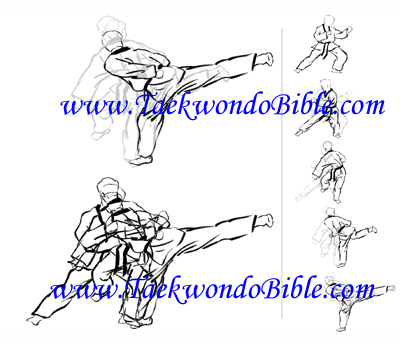
Part
II. PRINCIPLES
Chapter
12
Not
Losing Oneself
| |
"Haneul (Heaven) and Tang (Earth)
make oneness in Saram (Man). That is all."
|
|
Man(Saram) exists between Heaven (Haneul) and Earth (Tang). Heaven and
Earth derive their existence from man as they are divided from the one
entirety that is Man. All things that change relatively, i.e. that have
no inherent shape or form, are referred to by the name of Haneul (Heaven).
All things that are relatively fixed, i.e. that assume concrete form,
are referred to by the name of Tang (Earth). These categories each in
turn may be divided into that which contains a subjective which distinguishes,
and this belongs to the third category of Saram (Man). This distinguishing
subjective that marks man is the will to act.
TAEKWONDO is not exceptional in that it is also composed of these three
materials of Heaven, Earth, and Man (together known as the Samjae (»ïÀç[ß²î¦])18).
It is important that you should always maintain yourself as you are without
being led into a biased extremity in the battle against your opponent.
This is a third principle, called "the way of Saram". Some have
taught that this involves knowing oneself, or keeping to one's own sphere,
or as a sort of golden mean. To express it differently, the way of Saram
in Taekwondo is to return immediately to a settled pose, which is the
core of each of your motions. This settled core is in perfect balance
despite the endless changes and motions around it.
You, as a Taekwondo-Een who follow the way of Saram, should always keep
yourself sufficiently trained and under an intense regimen of practice
such that you never lose your way at any moment of Kyorugi19).
It should be as a sort of personal realm in which you live. Within that
realm you can be confident in your control over everything, and thus you
will never lose predominance over others since you include others within
your realm. By turn, if you broaden the possibility of this infinite position-keeping,
your predominance will vanish and you will attain everything, relying
solely upon your opponent's motion. This is possible because only after
you first know the existence of your "I" can you then understand
also the non-existence of the "I". It is essential for life
that every living thing manage all of its processes and activities with
a view towards self-preservation. Man is a life, and therefore, the way
of Saram is naturally closest to the figure of life among the three elements
of Samjae.
A plant begins as a seed, takes root, sprouts stems and leaves, puts
forth flowers which become fruit that contain again the essential seeds
of life. All of these changes occur because each stage, i.e. the seedling,
roots, the mature tree, are nothing but a plant breathing together with
the whole of nature from the deepest root to the tips of its many leaves.
Otherwise, a seed would die as a mere crumb and a mature tree would be
nothing more than a lump of wood.

Through all of these temporal processes the core, the essence, is the
state of "being a plant", and spatially this core is the earth
where it is rooted. Strength and weakness can only occur in being alive,
and the strength is no different from life's growth. This is the form
of the change of everything. The principle of Taekwondo is same as that
of Nature.
The core, as it applies to the way of Saram(Man), means your own perfect
pose which allows the most possibilities of adapting to each situation.
It is the true figure of each Taekwondo-Een. You should return to your
core naturally and immediately following each movement. This implies that
you never actually leave your core, but just extend yourself to various
figures before contracting back.
Since this core is each man's figure in practicing Taekwondo it is not
at all fixed, but rather is determined by the relation of you to your
opponent's motions, weapons, distance, and so forth. This is due to the
fact that you undergo endless change in nature. Since, however, this principle
is no more than an aspect of Taekwondo and everybody cannot but follow
its correct principle it is fixed at the abstract level.
The structure of this change lies in the fact that everything that man
conceives changes. Let us take a toy top for an example. Since the toy
top will be troubled in its spinning with its swaying core when it spins,
the core that regulates each change should be stable and firm. Once its
core is stable and firm it can spin on any surface and stand upright in
any situation.
Just as each part of the toy top turns swiftly back towards its core,
your motion should turn swiftly back towards your core, i.e. to your balanced
pose and position. Only the core of change can naturally link one change
to another. Accordingly, whenever you kick you should immediately drop
your foot back to its original pose, which makes the next skilled movement
possible swiftly and naturally. This applies equally to the techniques
of the hands.
<footnotes>
18) "Samjae" is the Korean term referring to the three elements
of Haneul(Heaven), Tang (Earth), and Saram(Man). These three elements are
not concrete things but abstract entities representing metaphysical concepts.
19) To put it most simply, Kyorugi means sparring. But Koreans can also
refer to life or death combat by the word Kyorugi. Thus the central meaning
of Kyorugi is close to sparring, but it can be more broadly nuanced to life
or death struggle.
|